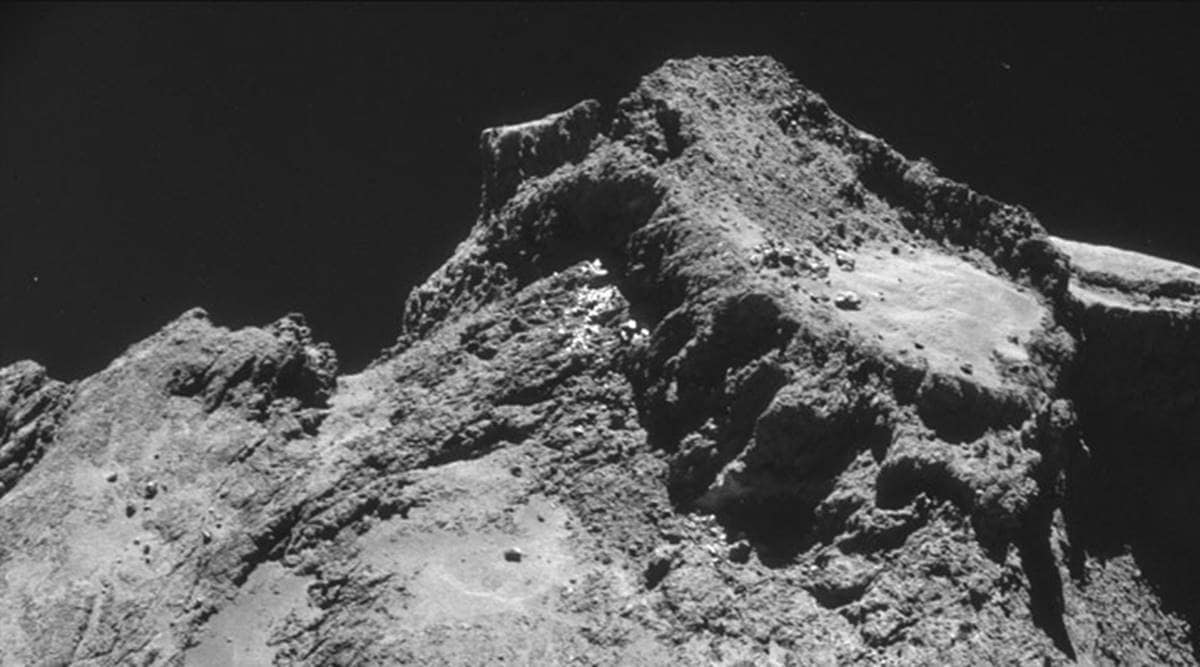 The picture taken with the navigation camera on Rosetta and released by the European Space Agency ESA shows the boulder-strewn neck region of Comet 67P/Churyumov–Gerasimenko, with the smaller lobe on the left and the larger lobe on the right. It was captured from a distance of 9.7 km from the center of the comet (about 7.7 km / 4.8 miles) from the surface) on Oct. 28, 2014. On Wednesday, Nov. 12, 2014 the Philae lander will be detached from Rosetta to land on the comet. (Source: AP Photo/ESA)
The picture taken with the navigation camera on Rosetta and released by the European Space Agency ESA shows the boulder-strewn neck region of Comet 67P/Churyumov–Gerasimenko, with the smaller lobe on the left and the larger lobe on the right. It was captured from a distance of 9.7 km from the center of the comet (about 7.7 km / 4.8 miles) from the surface) on Oct. 28, 2014. On Wednesday, Nov. 12, 2014 the Philae lander will be detached from Rosetta to land on the comet. (Source: AP Photo/ESA)Scientists have found in new research that at least one of the building blocks of life can form in the harsh environment of interstellar space away from stars and planets. As per the results published in Nature astronomy, glycine, an amino acid that is crucial for any form of life can form in dense interstellar clouds. It was earlier thought to be formed only in irradiation from stars.
This process can happen without energetic irradiation and the process has been named “dark chemistry”. The results were achieved in experiments at Laboratory for Astrophysics at Leiden Observatory, Netherlands. So far, the amino acid Glycine has been detected in our neighbouring planet Venus and a meteorite. It has also been detected in comet 67P/Churyumov-Gerasimenko.
The international team consisting of astrophysicists and astrochemical modelers studied the samples of the comet brought back to Earth via the Stardust mission. Glycine can be formed on the surface of icy dust grains without any UV radiation.
“In the laboratory,” said the astrochemist Sergio Ioppolo of Queen Mary University London in the UK, “we were able to simulate the conditions in dark interstellar clouds where cold dust particles are covered by thin layers of ice and subsequently processed by impacting atoms causing precursor species to fragment and reactive intermediates to recombine.”
To be able to prove the hypothesis, scientists used methylamine-enriched ice as a precursor compound for the reaction. Then, it was cooled at an interstellar temperature of -260 degree celsius in an ultra-high vacuum system called SURFRESIDE2.
It is unlikely that glycine formed at this temperature could lead to life forms in such harsh environments but it proves that they were formed even before the formation of stars. Further, glycine can then act as a precursor to other complex molecular compounds in these harsh conditions that we don’t know of yet.
“Following the same mechanism, in principle, other functional groups can be added to the glycine backbone, resulting in the formation of other amino acids, such as alanine and serine in dark clouds in space. In the end, this enriched organic molecular inventory is included in celestial bodies, like comets, and delivered to young planets, as happened to our Earth and many other planets,” Ioppolo further explained.
Express Tech is now on Telegram. Click here to join our channel (@expresstechie) and stay updated with the latest tech news.